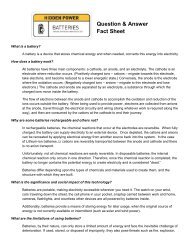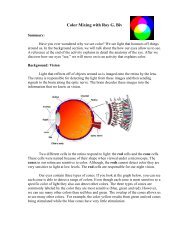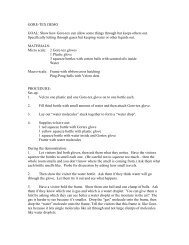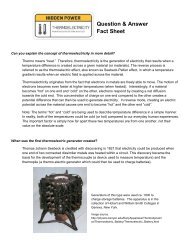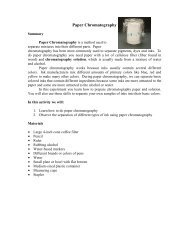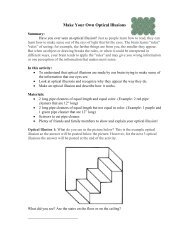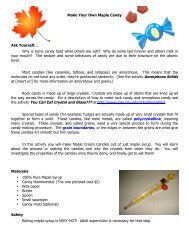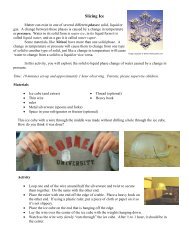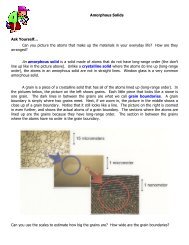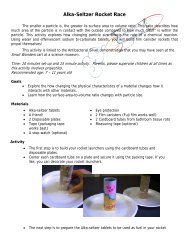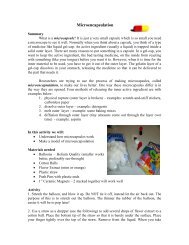Executive Summary Final - the Center for Nanoscale Science - an ...
Executive Summary Final - the Center for Nanoscale Science - an ...
Executive Summary Final - the Center for Nanoscale Science - an ...
Create successful ePaper yourself
Turn your PDF publications into a flip-book with our unique Google optimized e-Paper software.
IRG 1: Strain-enabled Multiferroics<br />
RESEARCH HIGHLIGHTS AND PLANS:<br />
Strong Ferroelectric Ferromagnet through Spin-Phonon Coupling: Fennie <strong>an</strong>d Rabe predicted<br />
that a paraelectric <strong>an</strong>tiferromagnet such as EuTiO3 will become a ferroelectric ferromagnet<br />
under biaxial tension or compression. The Schlom group syn<strong>the</strong>sized <strong>the</strong>se films under biaxial<br />
tension <strong>an</strong>d compression using oxide MBE with very high crystalline quality (15 arc sec X-<br />
ray rocking curve width) <strong>an</strong>d control over <strong>the</strong> Eu 2+ oxidation state, as confirmed by Freel<strong>an</strong>d at<br />
Argonne National Lab. The Gopal<strong>an</strong> group confirmed using optical second harmonic generation<br />
that <strong>the</strong> films are mm2 in biaxial tension <strong>an</strong>d ferroelectric below 140K. Orlita (Grenoble,<br />
international collaborator) confirmed <strong>the</strong> magnetoelectric effect <strong>an</strong>d Kamba (Czech republic,<br />
international collaborator) confirmed <strong>the</strong> relev<strong>an</strong>t soft modes <strong>an</strong>d dielectric <strong>an</strong>omaly at <strong>the</strong> ferroelectric<br />
tr<strong>an</strong>sition. The Schiffer group confirmed a ferromagnetic tr<strong>an</strong>sition below 3K using<br />
SQUID measurements. Johnston-Halperin at Ohio State confirmed <strong>the</strong> ferromagnetic state using<br />
magneto-optic Kerr effect (MOKE) experiments. The next step will be to show that electric<br />
fields c<strong>an</strong> modulate magnetism <strong>an</strong>d vice versa. The Rabe group has predicted that SrMnO3 will<br />
be <strong>the</strong> “next EuTiO3”, but with a higher ferromagnetic tr<strong>an</strong>sition temperature, ~100K. Experiments<br />
are underway to test <strong>the</strong>se predictions.<br />
(Left) Ferroelectricity: Optical second harmonic generation hysteresis loop <strong>an</strong>d <strong>the</strong> corresponding polarization<br />
loop <strong>for</strong> EuTiO3/DyScO3 at 5K. (Right) Ferromagnetism: Magneto-optical Kerr effect (MOKE) measurement at<br />
2.0 K <strong>for</strong> EuTiO3/DyScO3 (red open circles), EuTiO3/SrTiO3 (blue open squares), EuTiO3/LSAT (green open diamonds),<br />
<strong>an</strong>d DyScO3 substrate (gold open tri<strong>an</strong>gles). Ref. [1].<br />
Strain-Induced Isosymmetric Phase Boundary in Multiferroics: The IRG has recently shown<br />
that strain c<strong>an</strong> induce a morphotropic phase boundary in multiferroic BiFeO3 films. Strain c<strong>an</strong><br />
tr<strong>an</strong>s<strong>for</strong>m a rhombohedral phase to a tetragonal phase, <strong>an</strong>d <strong>the</strong>se two phases coexist in a single<br />
material, with commensurate boundaries, even though <strong>the</strong>re is nearly 10% lattice strain upon<br />
tr<strong>an</strong>s<strong>for</strong>ming from one phase to <strong>an</strong>o<strong>the</strong>r. We have also shown that electric field c<strong>an</strong> reversibly<br />
switch between <strong>the</strong> tetragonal <strong>an</strong>d rhombohedral phases, thus leading to large piezoelectric <strong>an</strong>d<br />
polarization switching characteristics. The emergence of enh<strong>an</strong>ced spont<strong>an</strong>eous magnetizations<br />
in self-assembled, epitaxial n<strong>an</strong>ostructures of tetragonal (T-phase) <strong>an</strong>d rhombohedral (R-phase)<br />
phases of multiferroic BiFeO3 was demonstrated. X-ray magnetic circular dichroism based photoemission<br />
electron microscopy (PEEM) was applied to investigate <strong>the</strong> local nature of this mag-



